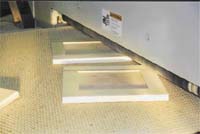Reprinted with permission from Modern Woodworking Magazine.
Whenever grains run in different directions, as in the production of frame doors, for example, there’s a risk that the sanding process will scratch across one of the grains. Even the slightest scratches show up as imperfections in the finishing process. One common solution to this problem is hand sanding with orbital sanders. This can be time consuming, however, as well as labor-intensive.
Wayne Pickurel, plant manager for Hooker Furniture, Martinsville, VA, recently faced this problem and found a different solution.
“We made the decision a few years ago to make a lot of our own doors in-house,” Pickurel said. “For the first year that we were making our own doors, we were running them down a production line, which was primarily a bed and mirror cabinet line, where we would sand the doors by hand with hand-held orbital sanders. Of course, when you are sanding doors you aren’t making any beds and mirrors, so that line was constantly behind schedule. Something had to be done.”
Doug Williams, Hooker Furniture executive vice president of manufacturing, agreed. “When you build a frame door and put the joints together, whether they are mitered joints or cope joints, you are left with grains that cross. Even after all of the time spent hand sanding, the finished product often is inconsistent. The employees might have sanded thoroughly for half the day and then slacked off after that,” he said.
The solution was to invest in a Timesavers Model 200 orbital wide belt sander. “About the time we were having our problem, Timesavers had developed this orbital sander,” Pickurel said. “We were among the first to purchase one and it has worked great for us.”

The Timesavers Model 200 orbital wide belt sander has allowed Hooker Furniture to effectively remove cross grain scratches from its door frames.
The first belt that the frame comes into contact with is the wide belt. Hooker uses 180 grit on this belt which is responsible for removing any scratches on the frame. As the frame moves forward in the machine, the oscillating heads sand it. Wrapped around these heads is a very fine 60-micron paper, which is responsible for the finish sand.
“With the oscillating motion and the use of very fine grits (up to 220 grit depending upon the material being sanded), we can eliminate any cross-grain scratches,” Williams said.
The sander worked so well it created a separate problem for the company. “The sanded doors were so slick that the stains would not penetrate the surface,” Pickurel said. “We quickly learned that we needed to back off of the grits being used.”
Reprinted with permission from Modern Woodworking Magazine. Free subscriptions are available by completing an on-line Subscription Form.